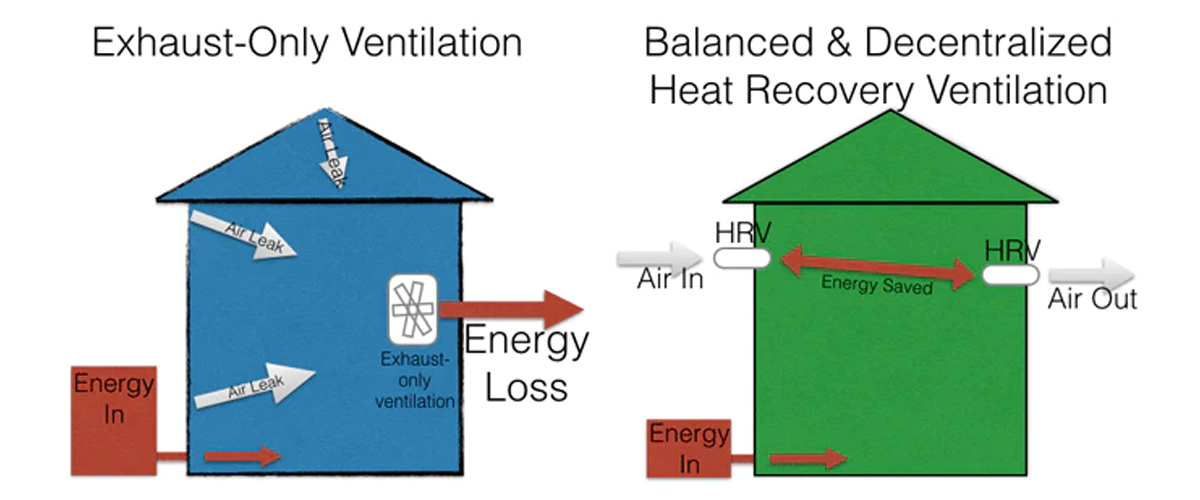Inaugural post of the Turning BS into Building Science series by Lucas Johnson
Most often, ventilation sucks.
When I was the third contractor enrolled in Energy Upgrade CA, I enjoyed being on the cutting edge of high performance building. However, ventilation was repeatedly one of the biggest challenges we faced as a state trying to push for affordable deep green buildings.
Then I moved to Seattle and became the in-house building scientist for Community Power Works. We retrofitted over 3,000 homes as well as hundreds of businesses ranging from mom-and-pops to CenturyLink Field. Again, ventilation plagued our work, resulting in wasted energy, unhealthy conditions, and maintenance headaches.
Here's why ventilation sucks.
The large majority of ventilation systems for smaller buildings are exhaust-only and run continuously or intermittently. In other words, they suck air out of a given room, most likely the bathroom, and then we basically just hope that the make-up air isn’t toxic or moisture-laden.
What we do know is that the best-case scenario is the make-up air is pulled directly from outside. Opening a window is the easiest way to make sure this happens, but that means pulling in 100% outside air that needs to be heated or air conditioned. A huge waste of energy!

Furthermore, if the bathroom window is open the bathroom fan will never work as your “whole-house” solution. Using the 2 cfm for each square inch rule, it only takes 40 square inches to allow 80 CFM to be pulled into the bathroom directly from outside. This means that opening a standard 30” bathroom window by only 1.33” would make it so that the bathroom fan is only pulling make-up air directly from outside which means NOT pulling air from anywhere else in the house.
Or, even more likely, the bathroom has the equivalent leakage area of almost 40 inches due to gaps such as the P-trap for the tub, the holes cut for the plumbing, electrical outlets, and the rough cut around the bath fan.
So how can we change home ventilation so that it stops sucking? By making it balanced. Even better, specifying a balanced ventilation system with heat recovery.
Balanced, Decentralized, Adaptable, Heat Recovery
Especially for tightly built and efficient homes, the most simple and cost-effective way to deliver balanced heat recovery ventilation is by using through-wall ventilation, because there is no ducting. The LUNOS e2 and LUNOS eGO work together as a modular system to create balanced heat recovery ventilation. Central HRV systems can work well; however, they are more expensive, the ductwork is always challenging, the central units require a large closet space, and the fan energy use can be significant for any central system.
The brilliance of the system is the simplicity. Sizing a LUNOS system is as easy as calculating the total CFM required based on square footage and occupancy, then adding units based on that calculation. Read our extended description on sizing LUNOS e² through-wall ventilation units. One eGO unit goes in each bathroom, providing continuous ventilation with heat recovery, and the option of exhaust ventilation when needed.
LUNOS systems are working now throughout North America. From Los Angeles to Maine to an off-shore Alaskan oil rig (seriously), they're being used for efficient ventilation for projects shooting for net-zero-energy levels of efficiency - they only draw about as much energy as an LED bulb. They've been installed and tested, with no freezing or defrosting, and have become the favorite ventilation system for off-grid cabins and tiny house enthusiasts across the country (see here, here, here, here, here, here, here ... you get the idea). It's also a great solution for multi-family projects, because you can completely separate spaces, without mixing of air between units.
Want to know more about why most ventilation sucks? Questions about how LUNOS can fit into your building project? Contact us to learn how we make high performance ventilation simple, affordable, and effective.



